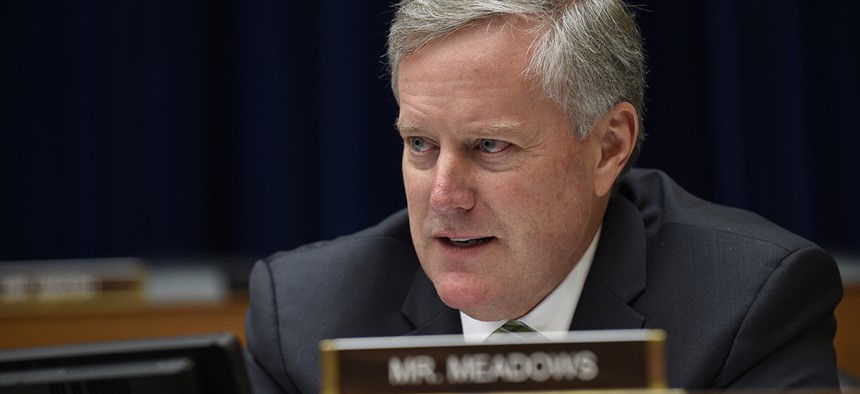OMB Will Revamp Payment Accuracy Website

House Oversight Committee member Rep. Mark Meadows, R-N.C. Susan Walsh/AP
House members demand better data, more progress on curbing improper payments.
Bowing to criticism of its data quality, the Office of Management and Budget will revamp the website paymentaccuracy.gov to improve agency reporting on efforts to curb improper payments, according to Controller David Mader.
The site, set up in 2010 in compliance with the Improper Payments Elimination and Recovery Act, assembles all agency data on current and past rates of improper payments, along with background on why agencies such as the Social Security Administration and the Centers for Medicare and Medicaid Services pay out billions to undeserving recipients.
Testifying on Thursday to the House Oversight and Government Reform Government Operations subcommittee, Mader told a skeptical Chairman Rep. Mark Meadows, R-N.C., that his predecessor Danny Werfel in 2010 “set up the site as the best way to satisfy the statutory reporting requirement. I arrived in the summer of 2014 and updated it in 2015 only to discover this June after meeting with [Oversight Committee] staff that it was not meeting the requirements, the letter and spirit of the law.”
Specifically, the website had 93 percent of governmentwide improper payments but was missing 7 percent. He told lawmakers that OMB “in the next couple of weeks will launch a complete redo to capture the data” in time for the January-March quarter. “This is also something the public needs to see,” Mader said, stressing transparency. “We have a great staff,” he said. “This one’s on me.”
Meadows confirmed his view that the existing data “don’t really correspond” with the kind of “good quality data” and “actionable items” that he and ranking member Gerry Connolly, D-Va., on a bipartisan basis, are seeking from agencies as they implement the 2014 DATA Act and the 2014 Federal Information Technology Acquisition Reform Act. “I don’t want to suggest just having a website is reporting,” Meadows said of Mader’s planned remake. “I’m optimistic and trusting, but we will verify.”
During the broader hearing, Meadows seemed impatient with witnesses from major departments who focused on the importance and complexity of their work to reduce bad payments when what he is looking for is progress in reducing the total, which reached $137 billion governmentwide in fiscal 2015.
“That’s the largest improper payments amount ever reported,” he said. “Total improper payments for the federal government over the past 10 years tops more than $1 trillion. We have a real problem here,” he said, noting, for example, that the error rate for Medicaid grew from 6.7 percent in fiscal 2014 to 9.8 percent in fiscal 2015.
Mader countered that “five years ago the percentage was higher, but the figure was lower, so there is some progress.”
Sheila Conley, deputy chief financial officer at the Health and Human Services Department, said her agency controls the government’s largest outlays, with over $1 trillion going out annually. “Of the seven risk-susceptible programs that reported improper payment rates in fiscal 2015, two programs reported improved performance and lower improper payment rates (Medicare fee for service and Foster Care), while five reported higher improper rates (Medicare Part C, Medicare Part D, Medicaid, the Children’s Health Insurance Program and the Child Care programs),” she said. The only program without an estimate on the improper payment rate is the Temporary Assistance for Needy Families program, she added.
“Due to the complexity of the corrective actions and program integrity initiatives, the results of these actions are generally not immediately reflected in the error rate measurement and can take years before the effect is realized,” Conley said.
Marianna LaConfora, assistant deputy commissioner for policy at the Social Security Administration, said “approximately 99.6 percent of all the Old Age, Survivor and Disability Insurance dollars we paid were free of overpayment, and nearly 99.9 percent were free of underpayment.” Cautioning that year-to-year changes are not statistically significant, she said, “This overpayment accuracy rate is our highest measured rate since fiscal 2003, while our underpayment accuracy rate is our highest since fiscal 2005.”
Jeffrey Schramek, assistant commissioner for debt management services at the Treasury Department’s Bureau of the Fiscal Service, outlined the department’s central portal for using advanced analytics to identify improper payments, whhich is called the Do No Pay list. In the first three quarters of fiscal 2016, he said, “agencies reported identifying nearly $18.4 million of improper payments through the use of DNP’s portal. This is more than double the amount reported in fiscal 2015 and is significantly more than previous years.”
Schramek noted that the Obama administration’s fiscal 2017 budget requested expanded authorities for data access. One proposal would change the law and allow all agencies access to the full Social Security Death Master File—currently restricted for privacy reasons—and a second would allow staff from authorized programs to access the HHS National Directory of New Hires data for use in matching identifies with claimed benefits.






